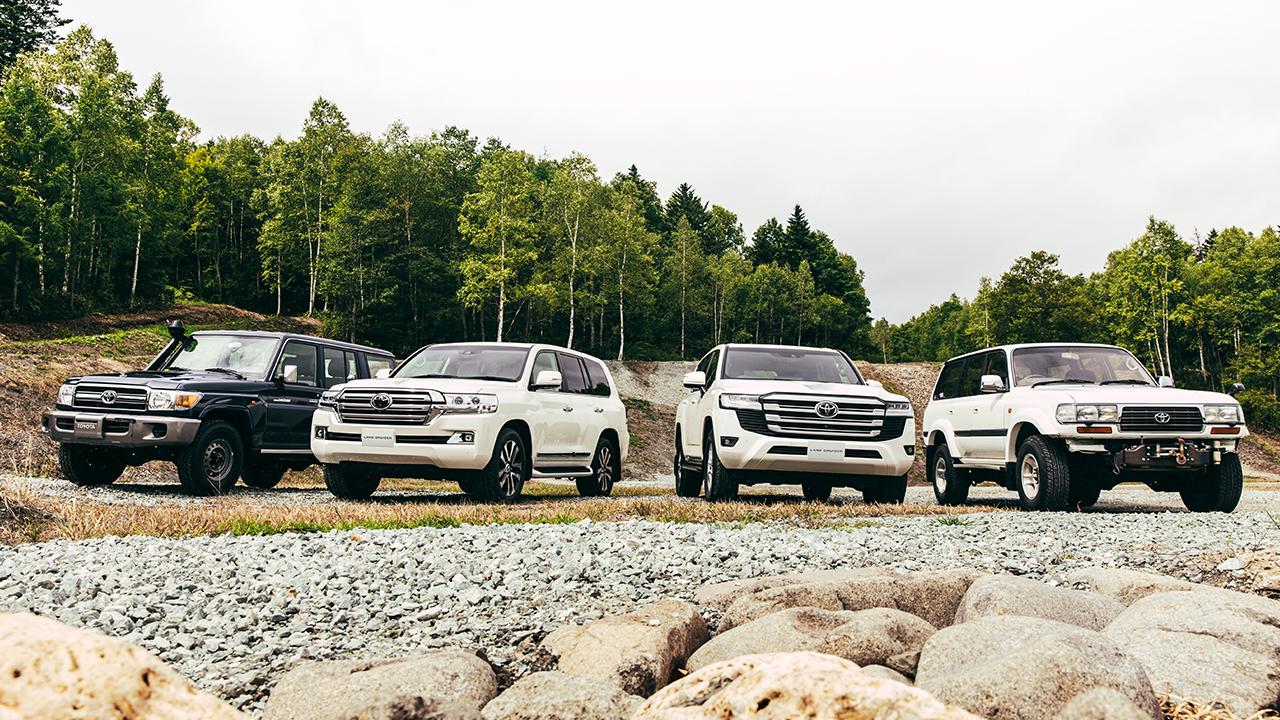
F-Course is a test course that recreates rough terrain from around the world. With his miraculous driving techniques, Land Cruiser Meister Takanobu Fukuoka shows how tough the roads are and how capable the Land Cruiser proves to be.

The F-Course, recreating rough terrain throughout the world
The F-Course at Shibetsu Proving Ground is surrounded by numerous tracks. Only a small part of this site was shown to the Toyota Times editorial team for this article series. The road leading to the course passes through a forest of conifer and white birch trees, and squirrels can be seen all over the place. It is a place blessed with a wealth of nature. The road eventually leads to a wide-open quarry-like space shaped like a basin. This is the start of the F-Course.
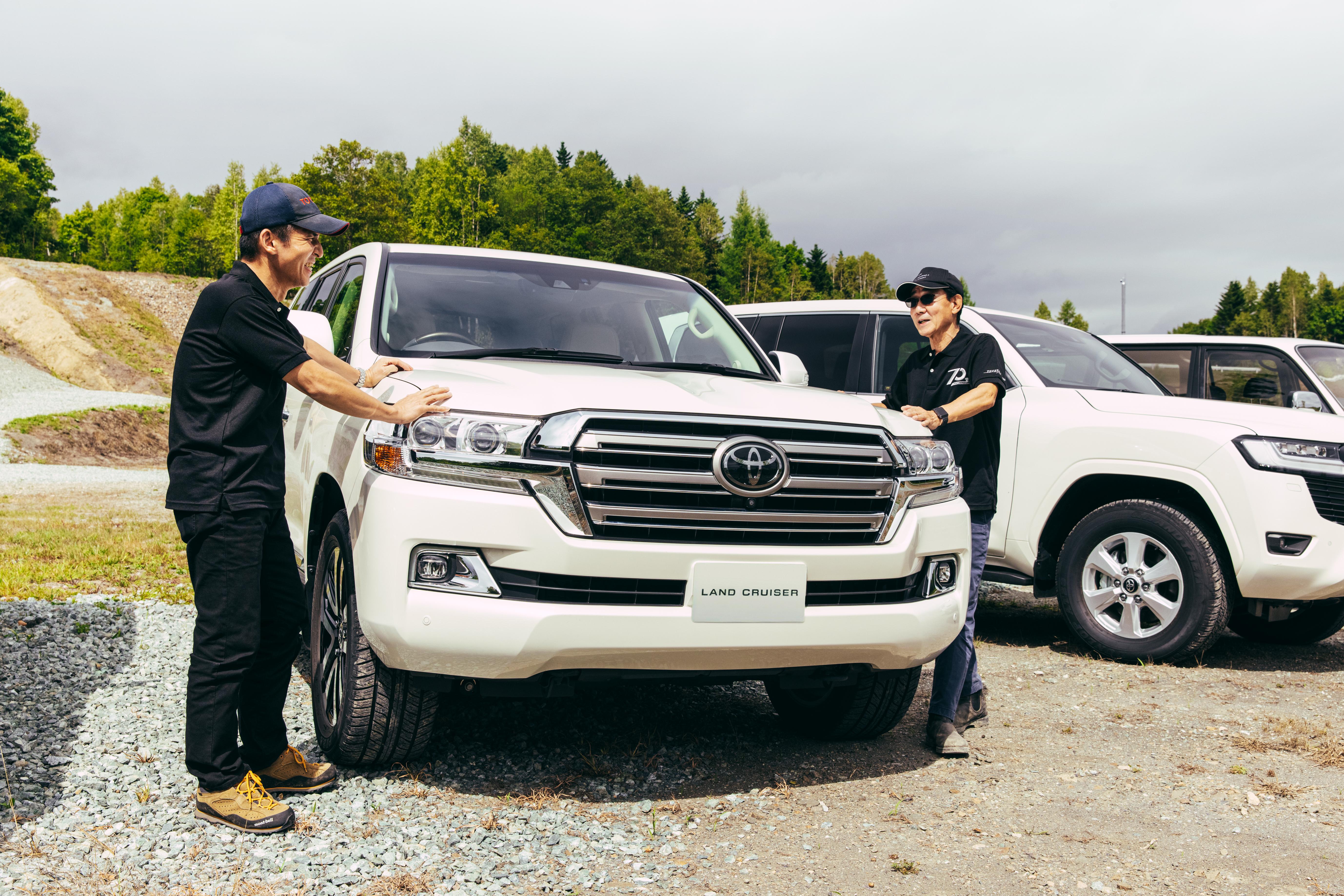
Heading to the test course in the Land Cruiser 70 Series, Takanobu Fukuoka and Sadayoshi Koyari exchange words saying, “There’s a bit more gravel.” “I agree.”
To the untrained eye, the space only looks like an unpaved parking lot, but in spring, it turns into a muddy road like those found in Russia when the frozen tundra thaws, and the two men were checking the boundary between the mud and the laid gravel.
Koyari explains, “We broke drive shafts here during tests at countless times.”
They then entered the course to check its surface condition.
“We’ll start with the mogul road known as the Camel’s Back. It’s used mainly for checking the suspension stroke and the transmission of power,” says Fukuoka.
Then he shifts the transfer case into low, and puts the engine into first gear with his foot still on the brake pedal. The engine is engaged, and there is some torque, like during creeping in an automatic transmission, but he is using the brake to keep the vehicle still. The vehicle can move forward with powerful torque when pressing the accelerator, but in addition, it enables subtle control over the torque during off-road driving. “This is what the Land Cruiser is all about,” says Fukuoka casually.

The moguls on the Camel’s Back are higher than the hood of the car, and they get higher the further you go. The furrows between the moguls are deep too, and misjudging the driving line will result in the ramp breakover angle being exceeded. This will cause the side sill to hit the ground, and the door will jam shut.
“This is the type of surface you often find in Southern Australia, inland from Sydney. The furrows are formed naturally by the flow of water over soft soil when it rains. It’s fun driving on roads like this for hundreds of kilometers in the sweltering heat,” says Fukuoka, smiling.
Clinging to the sides of two moguls to straddle the furrows, while constantly looking ahead to judge the sizes and angles of moguls that lie ahead, Fukuoka forges ahead as the car gets tossed around back and forth, left and right. He steers the vehicle slowly and carefully. It was later confirmed in photos taken on the Camel’s Back that the rigid suspensions* of the Land Cruiser 70 Series allow the entire axles to sway left and right as if they were dancing, to change the approach and departure angles through their strokes, keeping the tires in contact with the ground.
*Suspensions with the wheels on the left and right connected through the axles. They have a simple and solid structure, making them suitable for off-road driving
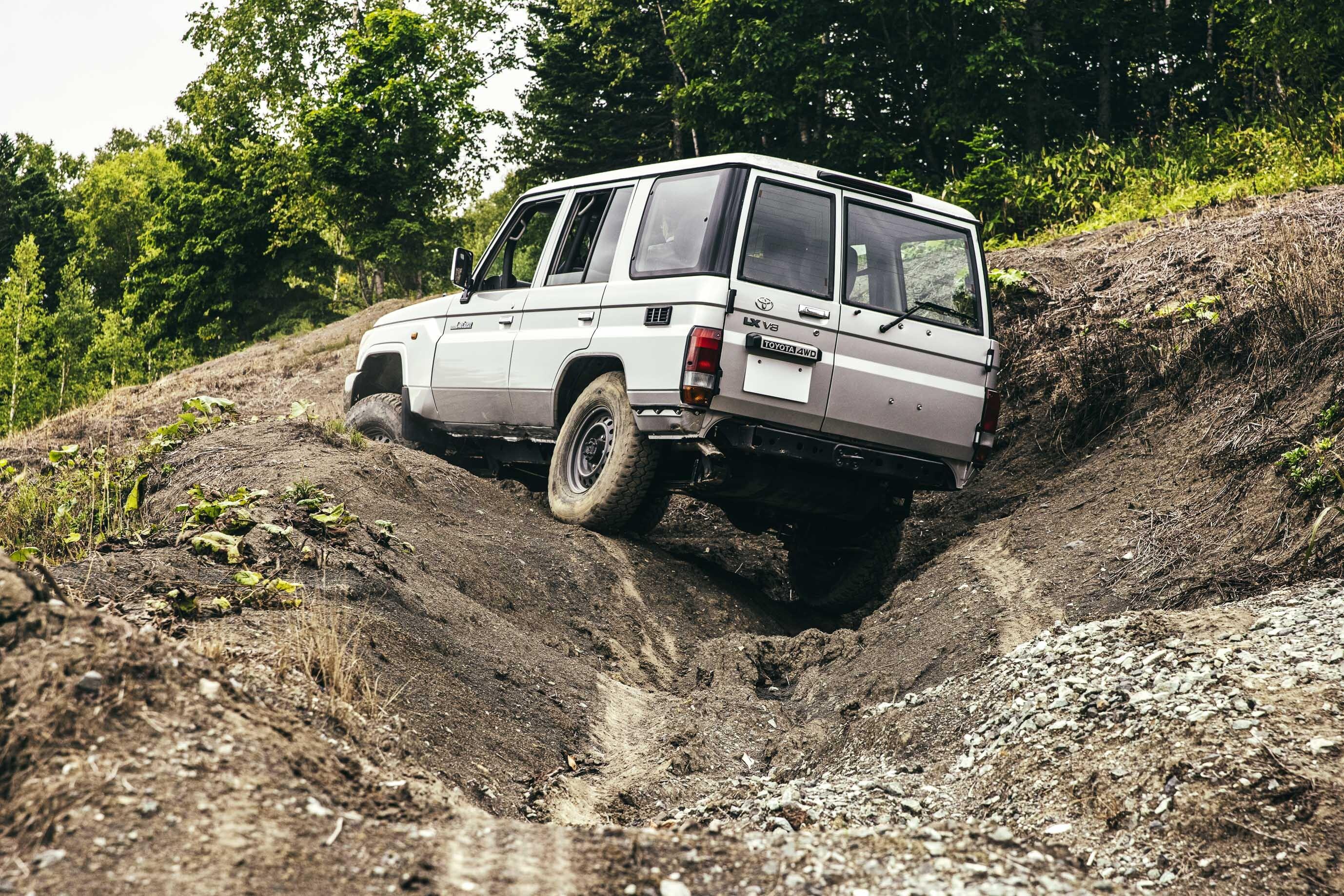
After the Camel’s Back was the first uphill road of the day. It was the same as the Camel’s Back in that it simulated soft ground over which a huge amount of water had flowed, but the bumps are irregular and the furrows are deep. From below, it doesn’t even look like a road – just a rough, dried up bed of a steep stream. This is another area for testing the suspensions and their strokes, but the steep incline makes it even tougher to get through than the Camel’s Back.
Fukuoka
Unpaved mountain roads like this are found everywhere in the world. The incline is about 25 degrees, making it an intermediate slope if it were a ski slope. It’s wet today, so it’s going to be a bit slippery.
Under these conditions, Fukuoka presses the accelerator slowly. When he detects a slip, he presses the accelerator, then releases it. The tires will only continue slipping if he steps on the accelerator. But the car will fall back if the accelerator is only released. By stepping on it before releasing it, the torque gradually decreases allowing him to figure out where the tires regain their grip. If they bite into the ground even a little, he gradually presses the accelerator again.
Using even the tire sidewalls is a basic off-road driving technique
Next, they take on the V-Mogul Uphill Road. This is a steep hill with the center of the road carved out in a V-shaped rut. The tires only come into contact with the surface on their outer edges, allowing testing of their lateral traction.
Fukuoka
This is the kind of surface found often in Moab of Utah in the U.S. The ground over there is red rock, so there’s better traction than what we have here, but the steep hills go on forever. So, if you make one mistake, the car could roll all the way down to the bottom.
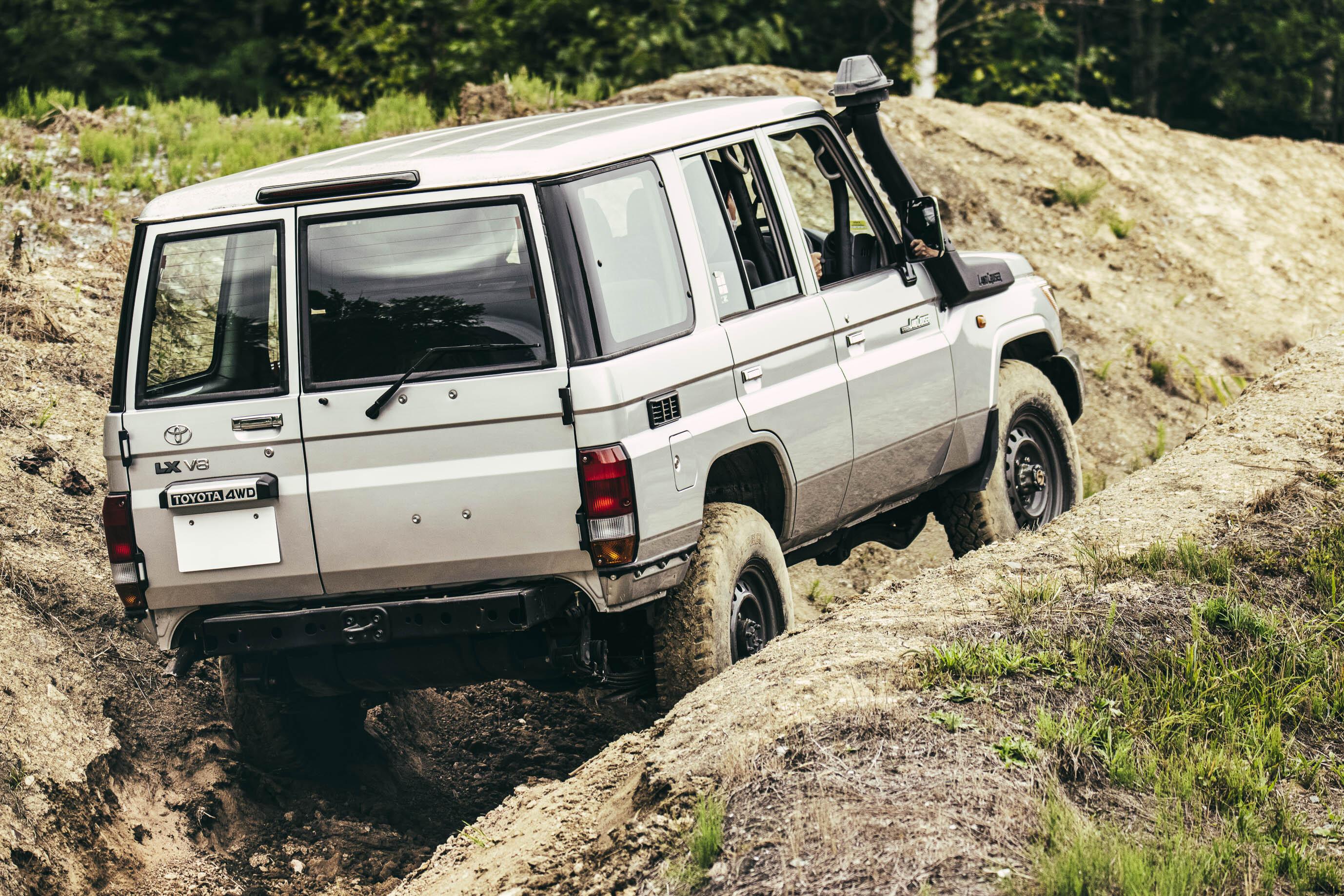
Only the surface of the hill had dried after rain, making it unstable, and even Fukuoka seemed to have difficulty getting through this section. But he worked the steering wheel to lean the vehicle to one side as far as he could go, and finally succeeded in moving forward. The tires slipped a little at times, but he used the accelerator skillfully to climb the hill without stopping. A later inspection of the tires revealed signs that the sidewalls had been used for traction to about the point where the tires are at their widest.
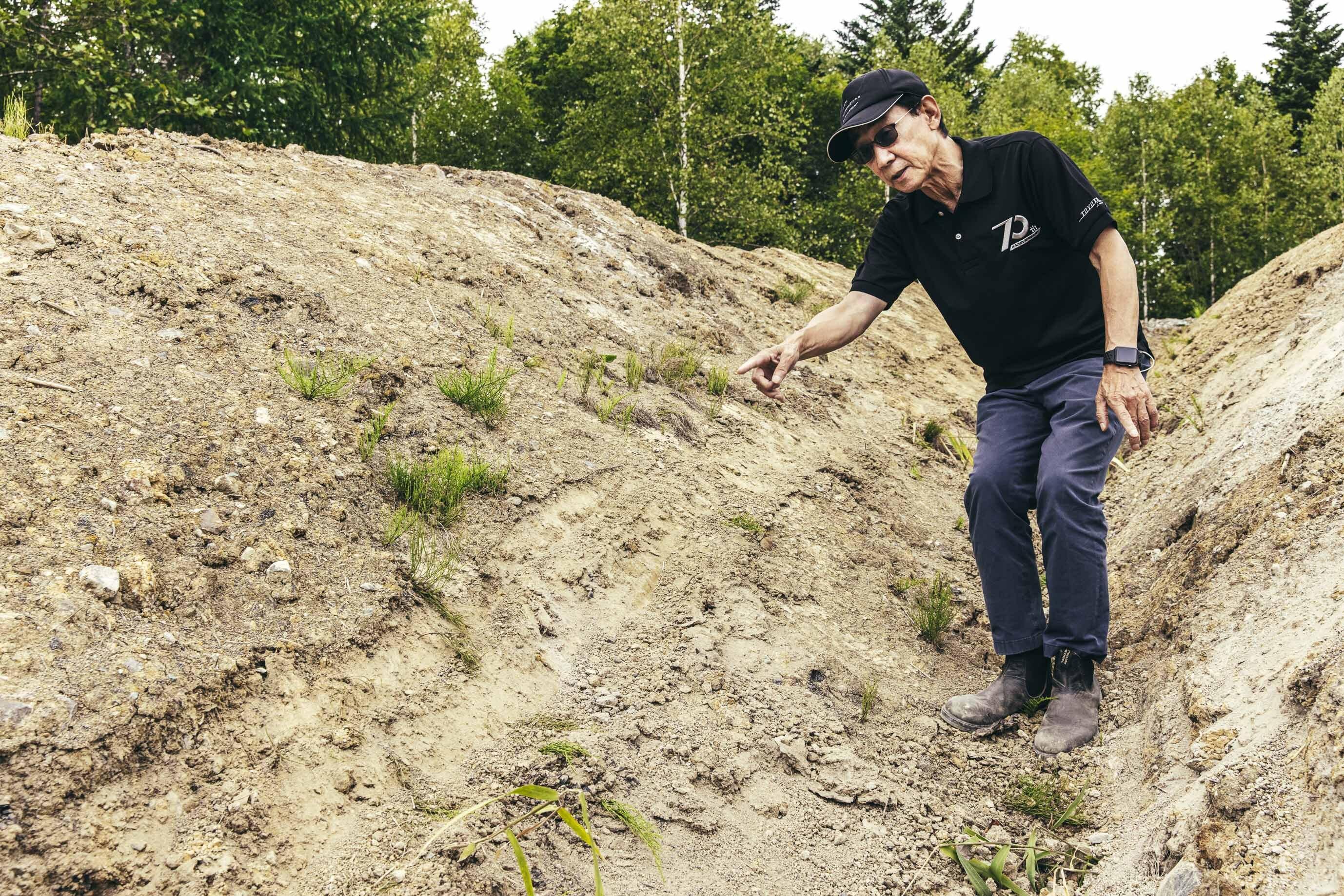
Fukuoka says, “Making maximum use of the tires is a basic off-road driving technique.” He later explained the track marks he had left in the mud resembled tracks left in the snow by skis. They testified to his superb driving skills, inspiring Koyari to ask that photos be taken of them.
“There’s one more thing you have to check in 4WD vehicles in terms of lateral traction. You climb up a large boulder by pressing the sidewall of the tire against it,” says Fukuoka.
Fukuoka pressed the front wheel against the vertical side of a rock so that enough of the tire sidewall was in contact with it. The hood rocked wildly as he tried approaching the rock from several different angles, but on this day, the Land Cruiser 70 Series had tires with no tread patterns on the sidewalls, and he was unable to climb all the way up the rock.

Fukuoka
The sidewall on this tire is too soft and it wasn’t able to withstand the pressure, which is why I couldn’t climb the rock. But when a tire slips off the rock, it can damage the sidewall, so this test can check the kind of damage that it may do. There are aftermarket products with tread patterns on the sidewalls, but they’re aerodynamically disadvantageous, so they’re difficult to install as standard features now with the stricter controls on fuel efficiency and certification. So, there’s a need to develop better off-road tires in the future.
Even Land Cruisers have their limit. Fukuoka does his best, but when he encounters such a situation, he accepts it.
Fukuoka
It’s the same with Land Cruiser users throughout the world. There are times in the wilderness when you have to drive the car into an obstacle on purpose to move forward. The Land Cruiser is designed to minimize the damage when you have to do this. The suspension arms, transmission protector and undercover in particular, are designed on the premise that they’ll be subjected to impacts.
The qualities required of test drivers, and the fostering of successors
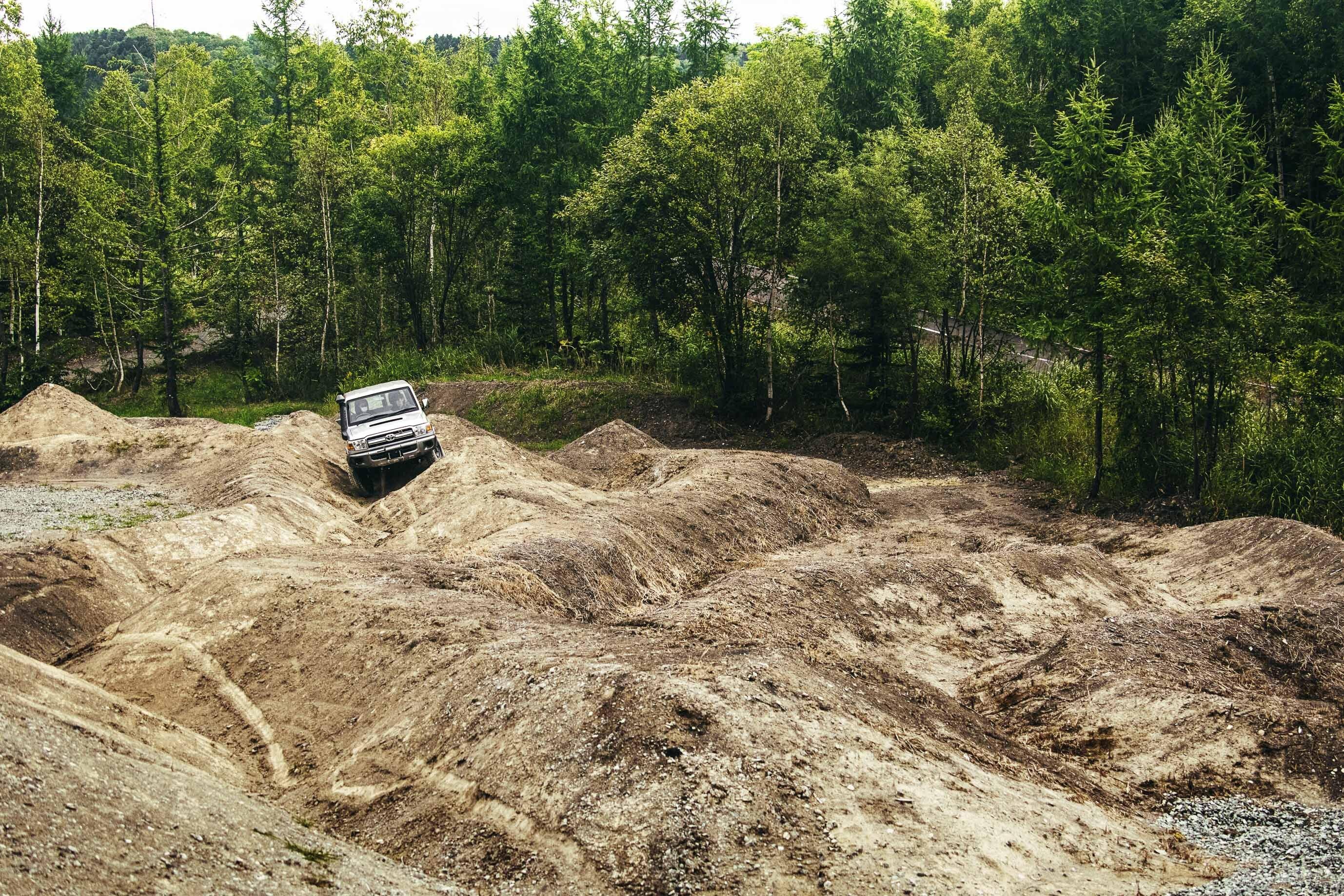
The Wave Mogul Course recreates such harsh conditions, with irregular, tightly packed moguls compared to the Camel’s Back, in addition to being on an upward incline. According to Fukuoka, it is a Wet Mogul Course where tests are carried out when the surface is wet.
A wet surface makes it even more slippery, making judgment of the driving line and working the accelerator more difficult. The Land Cruiser 100 Series and succeeding ones equipped with electronic control devices, such as Crawl Control and Active Traction Control, the driver can just concentrate on steering. Such electronic devices, which Fukuoka was also involved in developing, support the safe and secure transportation of customers living in harsh environments all over the world.
Koyari
The F-Course has all kinds of features that simulate off-road terrain. It actually seems as if it were in the wild nature, right? Nature isn’t easy, so we carry out repeated tests here until the cars break. It’s important to understand what their limits are.
As if to prove Koyari’s words, even the Land Cruiser 70 Series, with its long suspension strokes cannot avoid one or even two wheels from losing contact with the ground. But Fukuoka still manages to go over the moguls and furrows before him, and see what lies ahead as he moves forward with the tires firmly gripping the ground for traction.
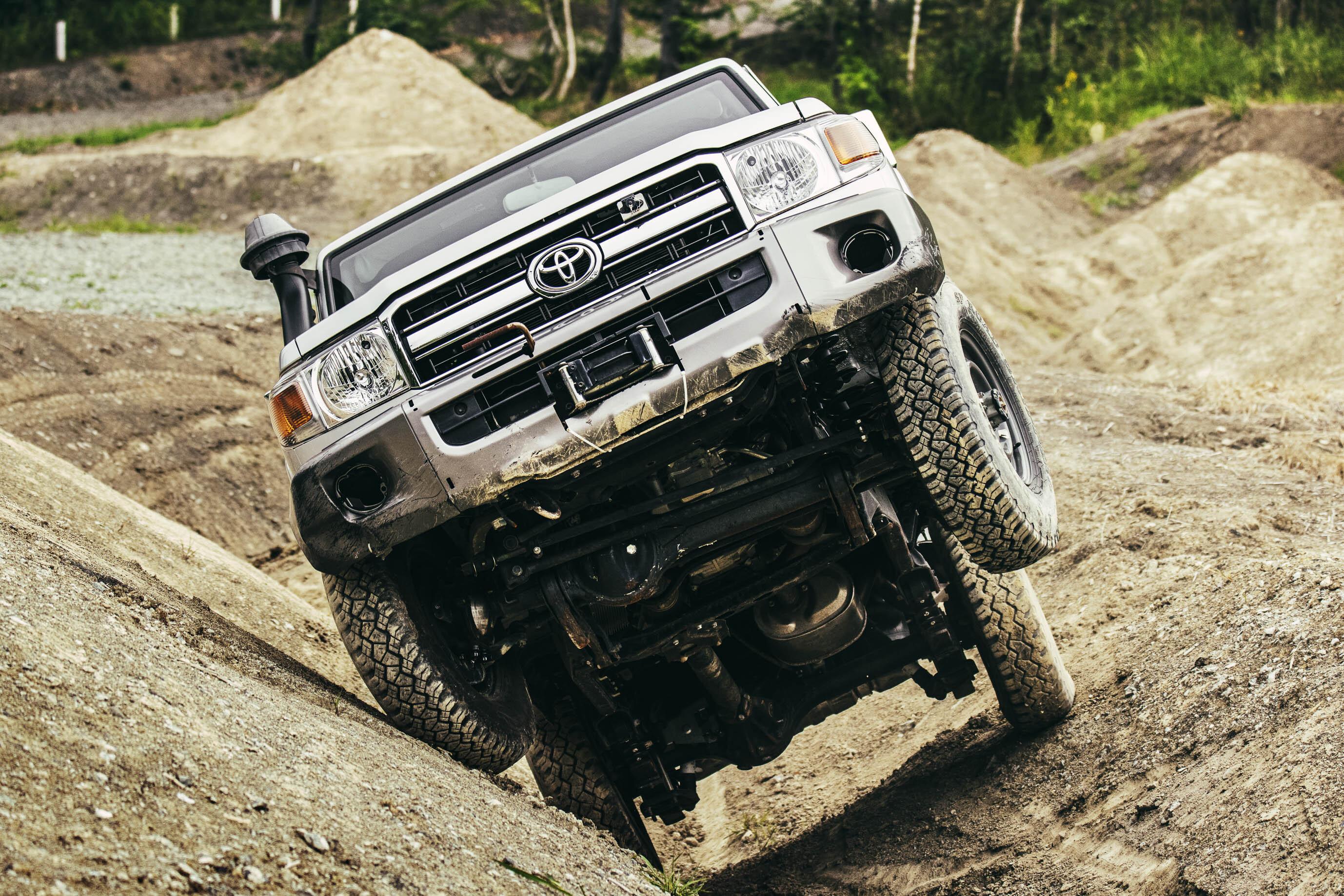
Fukuoka drove up a 42-degree hill that almost looks like a wall when seen from the front, and a steep rutted hill, as well as a course with rocks jutting out of the ground irregularly. But deeper inside the forest is apparently an even more difficult trail course. He drove around the F-Course as if it were his own backyard, and when the cameraman and reporter told him they had seen enough, he seemed disappointed, asking, “Are you sure you’ve seen enough?” Driving off-road may be his job, but he seems to genuinely enjoy it.
The F-Course allows testing vehicles for their drivability on rough terrain, which in the past was only possible to do overseas. As the Land Cruiser’s development concept is to overtake their predecessors in terms of reliability, durability and drivability on rough terrain, all the courses have been made to be a little harsher than the actual roads found around the world to help each model surpass the last. So, is there anything that cannot be tested on the F-Course?
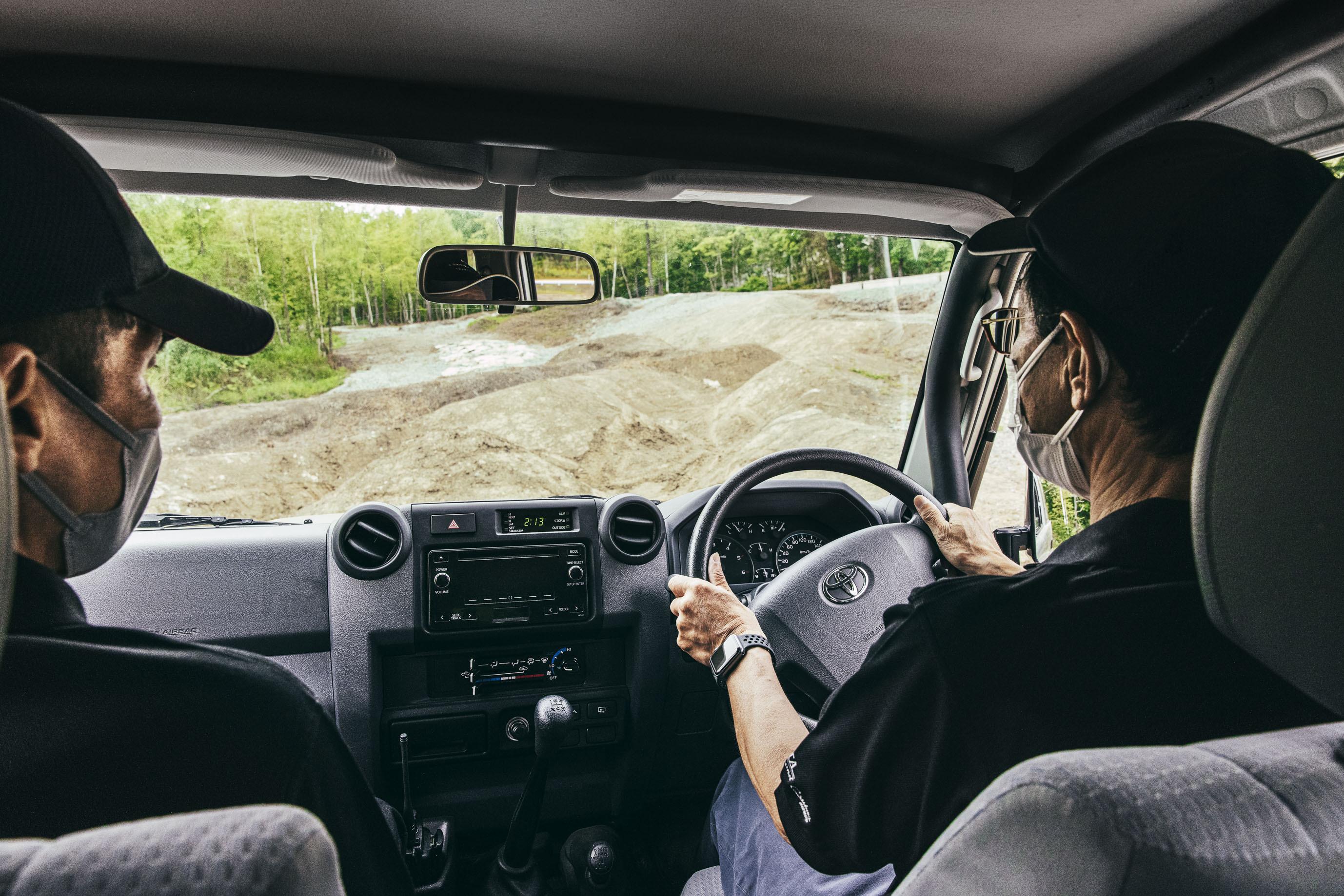
Koyari
Desert roads can’t be simulated. The quality of the sand differs depending on which desert you’re in. And even with the same sand, you can’t simulate the conditions unless the temperature, humidity and so on, are all the same. For example, the dry sand you find in the Middle East can’t be found in Japan. Carrying out tests on cars undergoing development requires you to take them overseas.
Fukuoka
We actually tried to recreate riverbanks covered in vegetation, like you find in tropical regions, but we couldn’t do it because of the difficulty of handling the water onsite. Rivers like that are often inhabited by crocodiles as we often come across them during test driving. We were told that we could have crocodiles on-site if nothing else.
Koyari
We can say a Land Cruiser meets all its requirements if it can be developed to get through the F-Course without any trouble. But the capabilities of a test driver don’t lie only in his driving skills. I mentioned before that Fukuoka has outstanding kaizen skills. At Toyota, we’re fostering future generations of drivers through a system of certifying off-road driving skills. But driving skills alone won’t lead to development.
For example, to develop an electronic control system, you have to carry out simulations by installing a hand-made control mechanism in the test vehicle first. So, you have to foster people who can engage in that kind of monozukuri. At TOYOTA GAZOO Racing and ROOKIE Racing, we actually implement initiatives to enhance monozukuri through racing, but we have yet to do this with off-road vehicles.
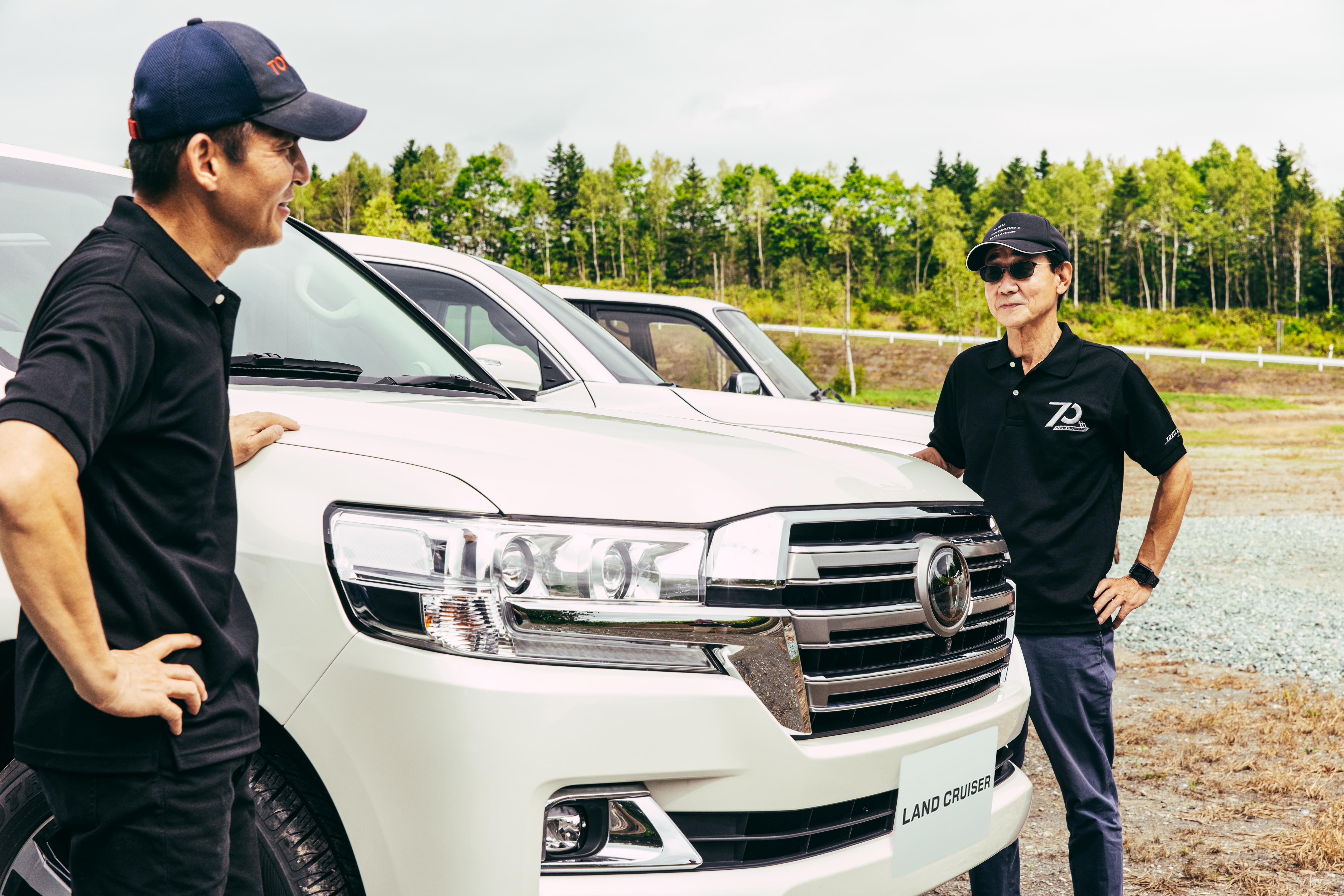
Fukuoka
I agree. I’ve strived to hone my kaizen skills to the best of my capabilities too. I concentrate on driving, while always thinking about how it can be improved. But most test drivers concentrate on driving and nothing else. Thinking about kaizen ends up going out the window.
Koyari
At Advanced Technical Skills Institute Div., they changed the way drivers are evaluated so they wouldn’t just concentrate on improving driving skills. We have to come up with sustainable ways to develop people for the Land Cruiser too. That’s what we need to think more about.
Roads improve cars and train people. The Land Cruiser’s unwavering mission and engineers’ passion is to provide a car that can go anywhere & everywhere and come back alive & safe. The F-Course is a test course, and is like a backyard that Fukuoka has devoted himself to landscaping. How the Land Cruiser evolves in the future for users all over the world lies in the hands of the next generation of drivers who will test it on this F-Course.
Takanobu Fukuoka
Fukuoka joined Toyota in 1971. He was assigned to the Vehicle Performance Testing Section of Engineering Division No. 3, where he was placed in charge of testing and evaluating the Century, Celica, Carina, EVs, etc. From 1982, he was placed in charge of testing and evaluating the Blizzard, and the Land Cruiser 60, 70, 80, 90, 100, 105, 120, 150 and 200 Series. He retired from Toyota in 2016, but in October that year, joined Toyota Technocraft Co., Ltd. (currently Toyota Customizing & Development Co., Ltd.), where he has been involved in the advanced development of the Land Cruiser 300 Series. His Land Cruiser development contract expired in 2021. Fukuoka is currently involved in constructing a test course for the LUNAR CRUISER, the manned pressurized rover jointly developed by JAXA and Toyota, and is carrying out tests on its driving performance.
Sadayoshi Koyari
Project General Manager, MS Product Planning, Mid-size Vehicle Company
Koyari joined Toyota Motor Corporation in 1985. As part of Engineering Division 1, he worked on chassis design for the Hilux and Land Cruiser Prado. From 1996, he was responsible for product development at Toyota Development Center 3; Since 2001, Koyari was involved in product development for the Land Cruiser and the new frame platform as Project General Manager. In 2007, he was appointed Chief Engineer at Toyota Development Center 1, and is currently in charge of the Land Cruiser 70 Series and the Land Cruiser Prado.

